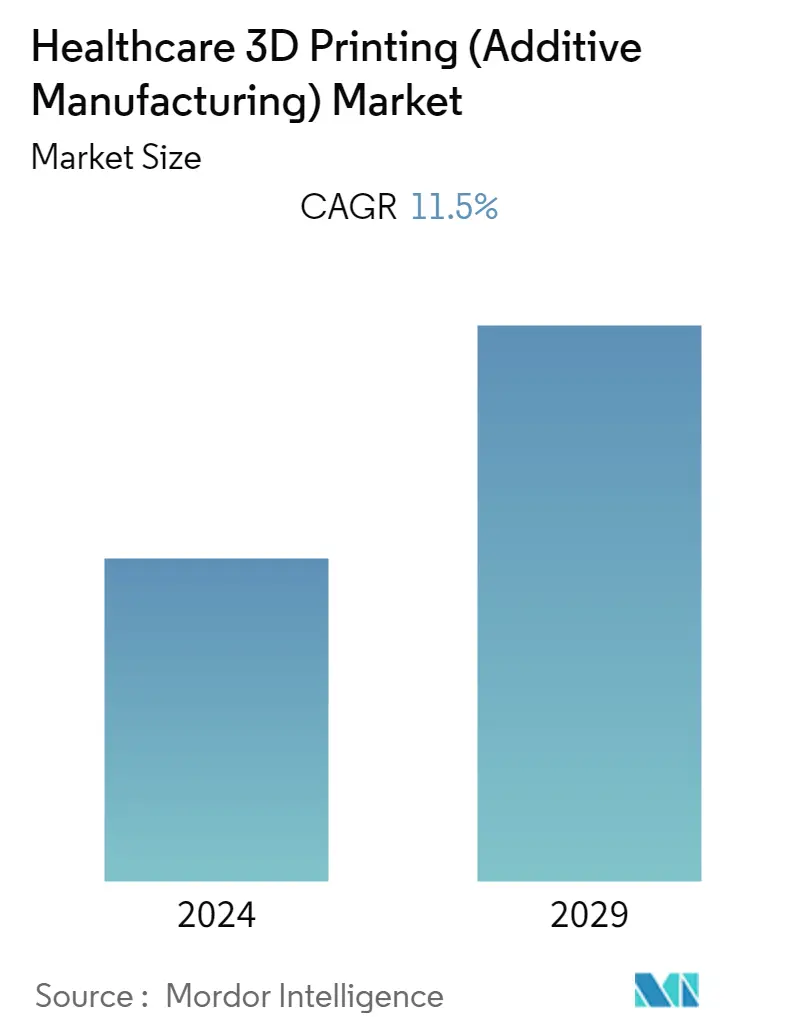Market Size of Healthcare 3D Printing (Additive Manufacturing) Industry

| Study Period | 2019 - 2029 |
| Base Year For Estimation | 2023 |
| CAGR | 11.50 % |
| Fastest Growing Market | Asia-Pacific |
| Largest Market | North America |
| Market Concentration | Medium |
Major Players
*Disclaimer: Major Players sorted in no particular order |
Need a report that reflects how COVID-19 has impacted this market and its growth?
Healthcare 3D Printing Market Analysis
The healthcare 3D printing (additive manufacturing) market is expected to register a CAGR of 11.5% over the forecast period.
COVID-19 significantly impacted the additive manufacturing field in its initial phases. It faced a lack of medical devices during the pandemic. Diverse designs were produced and used in hospitals by patients and health workers, and there has been an increase in the use of 3D-printed devices, such as face shields, masks, valves, and nasopharyngeal swabs. However, as the restrictions were lifted, the demand for the market is likely to increase in the coming years since complete automation and digital workflow are anticipated to be possible with additive manufacturing. In particular, additive manufacturing is likely to replace high-volume, serial production techniques that require both high resolution and high productivity at low cost.
Additive manufacturing, often referred to as 3D printing, has the potential to provide cost-efficient methods to produce highly complex and customized components, single parts, or small batches of products for the healthcare industry. It has numerous applications in the industry. Factors such as rising demand for customized additive manufacturing and demand for 3D printing, driven by increased medical applications, are major driving forces in the market's expansion. For instance, in March 2022, Zoriox Innovation Labs, consisting of a team of surgeons, dentists, mechanical engineers, biomedical engineers, software engineers, graphic designers, prosthetists, and anatomists, created a 360-degree solution for facial reconstruction using 3D printing technology. Moreover, in February 2022, South Carolina-based DeGen Medical Inc., a spinal implant manufacturer focused on Augmented Reality and Patient-Specific Solutions, commercially launched Impulse AM, a 3D-printed porous titanium implant for posterior interbody fusion.
Also, many hearing aids are 3D printed with current innovations and technological advancements, making it one of the important factors to positively drive this market over the forecast period. Further, technological advances are contributing to the market's growth. 3D printing in medicine can provide many benefits, like the customization and personalization of medical products, drugs, and equipment and increased productivity. For instance, in February 2021, Apollo Hospitals and Anatomiz3D Medtech collaborated to design and build hospital 3D printing labs in India that enabled doctors to visualize and print implants for complicated surgical cases. Furthermore, in April 2022, Desktop Health, a healthcare business that creates 3D-printing solutions for personalized medicine, launched the Einstein high-precision series of 3D printers and the Flexcera Smile Ultra+ resin for printing temporary and definitive restorations in the United States. This combination enables dental professionals to quickly generate accurate 3D-printed restorations.
As per the factors mentioned above, healthcare 3D printing (additive manufacturing) is likely to witness growth over the forecast period. However, the cost of additive manufacturing is still high, leading to affordability issues, especially in developing and underdeveloped countries. Also, there is a lack of skilled professionals to operate this machinery. These factors are anticipated to impede the market's growth.
